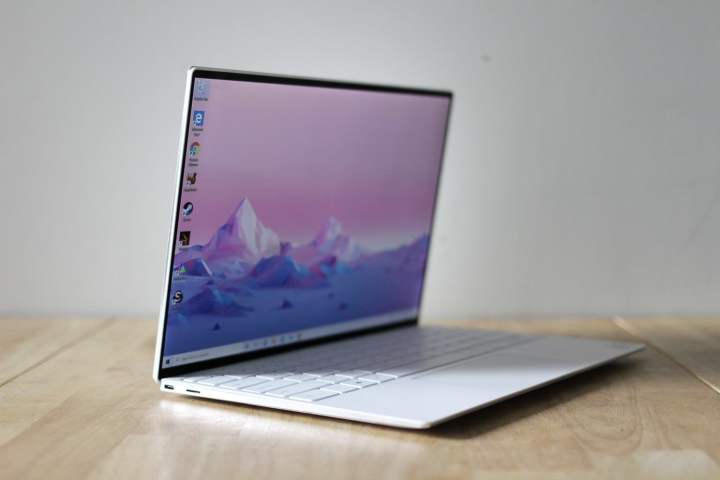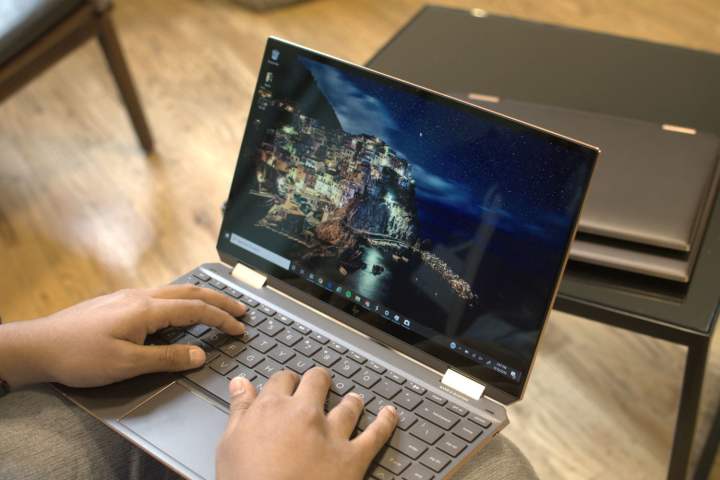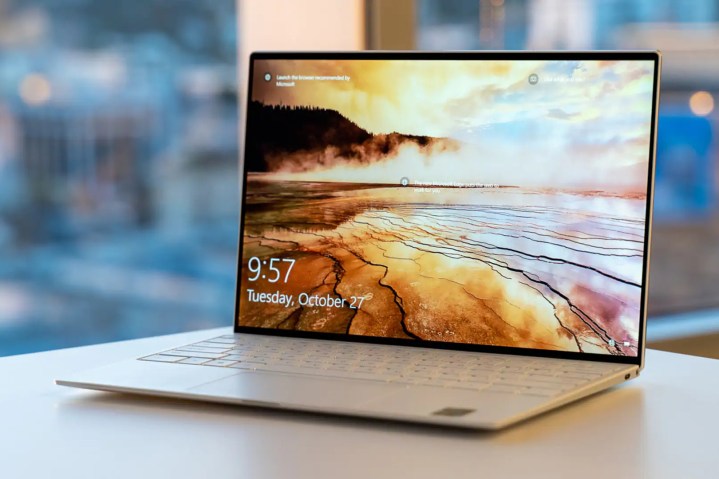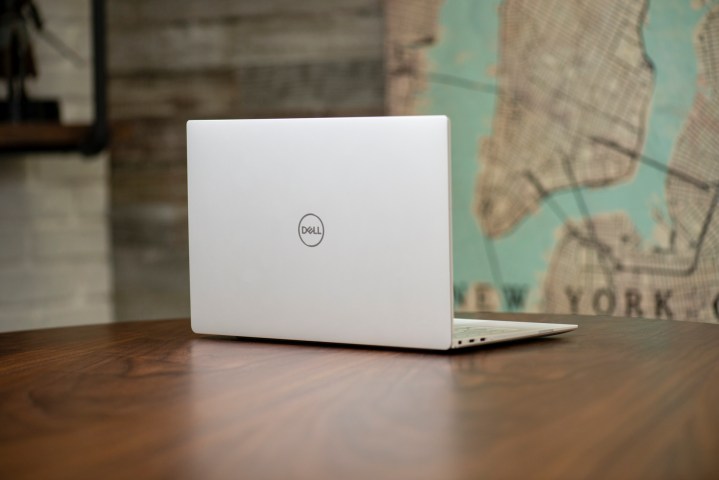The Dell XPS 13 is the best laptop we’ve tested at Digital Trends, and the recent refresh with Intel’s Tiger Lake processors makes Dell’s mobile behemoth all the more impressive. It’s thin and light, the keyboard is one of the best on the market, and the specs push the envelope in terms of mobile power.
But the XPS 13 doesn’t live in a vacuum. It’s an impressive machine, but there’s stiff competition from all sides. And there isn’t a machine that showcases that competition better than HP’s Spectre x360 13. With nearly identical specs and price, plus some extra visual flair, the Spectre x360 13 humbles even Dell’s best.
With so much the same between the two, it’s difficult to decide between the Dell XPS 13 and HP Spectre x360 13. In this guide, we dig into the details to find the best premium 13-inch laptop you can buy.
Pricing and configurations

Dell’s latest XPS 13 is powered by Intel’s 11th-gen Tiger Lake processors. The cheapest configuration comes with an i3-1115G4, paired with 8GB of ultra-fast memory (4,267MHz) and a 256GB NVMe hard drive, for $1,000. The most expensive configuration runs $1,700. It keeps the memory and storage the same but upgrades the processor to an i7-1165G7 and the screen to a 4K touch display.
You can configure the system yourself, too, with up to 16GB of memory and a 2TB SSD. If you configure 16GB of memory, the processor moves up to an i7-1185G7, as does the price. A high-end configuration will run $2,350.
The Spectre x360 13 starts at a slightly higher price: $1,080 new, and $980 on sale. That extra $80 buys you a nicer i5-1135G7 compared to the XPS 13, but the other specs are identical. The cheapest configuration comes with 8GB of RAM and a 256GB SSD.
A tricked-out configuration runs $1,880 and includes an i7-1165G7, 16GB of memory, a 4K touch display, and a massive 2TB NVMe SSD. HP offers configurations with 32GB of Intel Optane memory, too, paired with up to a 1TB NVMe SSD.
The two machines are almost identical. The cheapest XPS 13 comes with a worse processor, but Dell offers a configuration that matches the cheapest x360 for only $20 more. If there is an edge, it goes to the XPS 13 simply because there are processor options, which is by the far the most important component in this form factor.
Design

When it comes to looks and build quality, it’s hard to go wrong with the XPS 13 and x360 13. Dell’s model is familiar, short of a slightly reworked hinge, and it comes in two colors: Silver with a black interior, or Frost with a white interior.
HP’s x360 is a little more flashy with diamond-cut corners and lovely Spectre logos adorning each of the hinges. It has more color options, too, including silver, black and gold, and navy with silver accents. We’ll get into dimensions later, but the two laptops are mainly on par. Technically, however, the XPS 13 is slightly thinner and lighter.
As for typing, the XPS 13 and x360 are the best of the best when it comes to laptops (short of the Magic Keyboard on Apple’s latest MacBooks). A lot of it comes down to preference, but the x360’s keys have more travel than the Dell’s. The 2020 XPS 13 does improve on previous models, however, changing out the butterfly mechanisms for a more tactile feel, and moving the page up and page down keys away from the arrow keys.
The two aren’t equal when it comes to port selection, though. The XPS 13 continues the trend of Dell removing ports, featuring a single Thunderbolt 4 port on each side of the laptop, as well as a 3.5mm headphone/microphone combo jack and a MicroSD card reader.
The x360 13 comes with a pair of Thunderbolt 4 ports, as well, in addition to a 3.5mm jack. It trades the MicroSD port for a USB 3.0 Type-A port, however. Considering you’ll need a dongle with both machines, the USB-A port on the x360 13 is a useful addition.
As for wireless connectivity, the two machines are equally matched, sporting the latest Wi-Fi 6 and Bluetooth 5. The x360 13 also supports LTE on certain models.
Performance

Intel’s 11th-gen Tiger Lake processors are the star of the show for both the XPS 13 and x360 13, and Dell and HP have mostly the same options. For HP, you have the option between the i5-1135G7 and i7-1165G7. Dell matches those offerings in its high-end configurations, but also offers a less powerful i3-1115G4 model and a more expensive i7-1185G7.
At their respective prices, the i7-1165G7 is the ideal choice. It’s a four-core, eight-thread part that can turbo up to 4.7GHz, and it comes with Intel’s new Xe graphics.
Processor power rules the roost in this form factor, and both Dell and HP deliver. Benchmarks show nearly identical scores between the two across PCMark, Cinebench, Photoshop, and more. Out of the Tiger Lake laptops we’ve tested, only the Acer Swift 5 beats the XPS 13 with an identical configuration.
Gaming is an important benchmark with Intel’s new mobile range, too. Testing a slightly more powerful i7-1185G7, we found that Intel’s new Xe integrated graphics could produce playable frame rates in Battlefield V and Civilization VI. A dedicated GPU is still essential for any serious gaming, but the XPS 13 and x360 13 can play the role of lightweight gaming notebooks once you wrap up your work. It can play that role, but only in certain titles. Fortnite, for example, couldn’t manage 30 fps in our testing, even at Medium settings.
In 2021, Tiger Lake processors rule the mobile market, and that is becoming increasingly clear as more models release. And the XPS 13 and Spectre x360 are two models that put the hardware to excellent use. There’s virtually no difference in performance between identical configurations, putting the focus on battery life, design, and the keyboard.
Display

Internally, the two laptops are mostly equal, but there are some significant differences externally. For HP’s x360 13, a touchscreen is the standard. No matter what model you choose or what resolution — HP offers 1080p and 4K — you’re getting a touch display. HP offers an OLED display with certain CPU configurations, too, sporting much deeper contrast and a peak brightness of 400 nits.
Dell doesn’t offer an OLED option, though it’s not down for the count. XPS 13 models come in either FHD+ or UHD+ with a peak brightness of 500 nits and support for Dolby Vision HDR. The “+” bit comes from the 16:10 aspect ratio on the XPS 13, giving you a few hundred extra pixels horizontally.
The extra pixel count may not sound like much, but it makes a difference. Dell has been using its InfinityEdge displays for a while, so combining a slightly wider aspect ratio with little in the way of bezels, the XPS 13 can simply fit more things on screen than the x360 13.
Portability

The XPS 13 and x360 13 are both thin and light laptops, though the Dell model is slightly thinner and lighter. For the non-touch model, the XPS 13 clocks in at 2.64 pounds to the x360 13’s 2.8 pounds and measures only 0.58 inches thick (the x360 13 is 0.67 inches thick). The x360 13 is also around half an inch wider than the XPS 13.
Even with the differences, you’ll rarely, if ever, notice a difference between the two. They’re basically the same in terms of size and weight, so unless you can discern a difference of a 10th of an inch, you shouldn’t worry about size.
You should worry about battery life, however. The XPS 13 comes with a 52-watt-hour (Wh) battery, while the x360 13’s battery is rated for 60Wh. Based on the size of the battery alone, the HP laptop beats the Dell laptop every time. Testing local video playback, we found the x360 lasted around three and a half hours longer than the XPS 13 with a standard 1080p display. With the OLED display, the x360 drops below the XPS 13, but only by a bit.
It’s important to remember the XPS 13’s aspect ratio here. Powering the display is one of the biggest strains on your laptop’s battery, and the XPS 13 is simply pushing more pixels than the x360 13. It’s a small difference, sure, but combined with the x360’s larger battery, HP is the clear winner when it comes to battery life.
We wouldn’t recommend the 4K version of either laptop if you’re worried about battery life, though. Expect to lose three to four hours on average battery life with a higher resolution display.
Two excellent laptops, but which should you pick?

When it comes to specs, performance, and price, the XPS 13 and Spectre x360 13 are basically the same. If function is your only concern, there’s virtually no difference between two identical configurations. You’re going to have to get down to the smaller details to choose which is the best laptop for you.
There are plenty of tiny benefits to consider with the x360 13, such as its extended battery lifespan and its incredible OLED display option. On the other hand, the XPS 13 holds its own in other aspects such as a larger screen as well as a more expansive set-up of hardware and software.
Considering there is practically no substantial difference between these two laptops, we don’t think there is really an unequivocal winner. Most of it comes down to users’ screen, typing, and design preferences.



